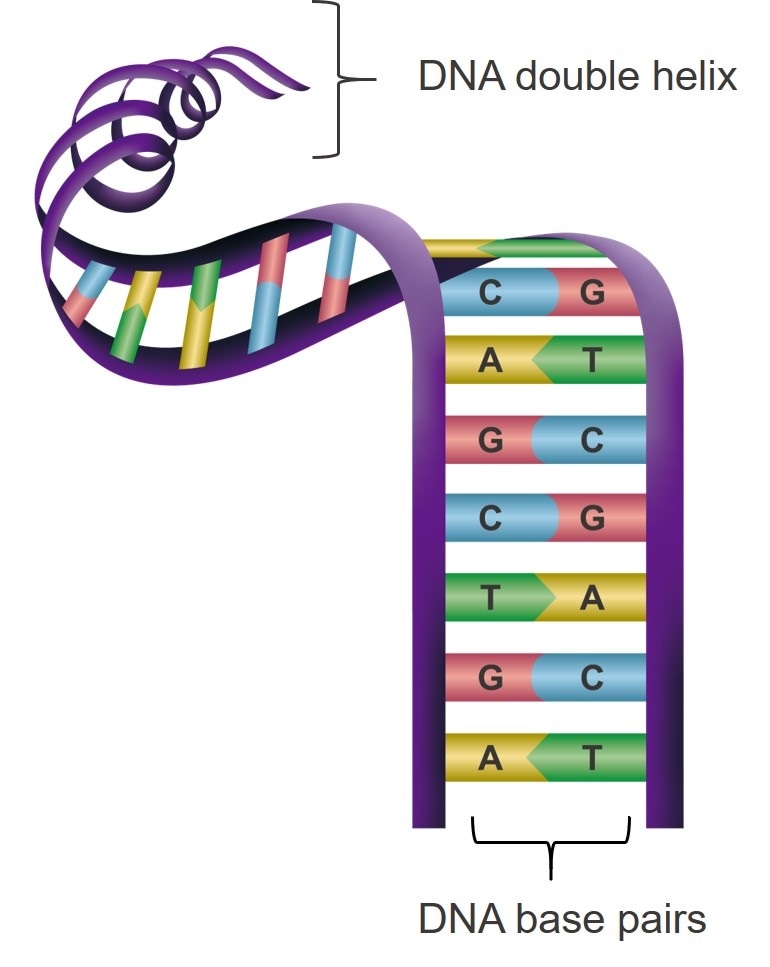Scientists from the Okinawa Institute of Science and Technology Graduate University (OIST) employed minuscule DNA strands to direct the building of viewable gel blocks.

Base pairing is a very specific process which can be used to design matching strands. Image Credit: Okinawa Institute of Science and Technology Graduate University.
According to the researchers, the hydrogel blocks, which extend up to 2 mm in length and carry DNA on their surface, self-assembled in around 10–15 minutes when mixed in a solution. The results were published in the Journal of the American Chemical Society.
These hydrogel blocks are, we believe, the largest objects so far that have been programmed by DNA to form organized structures.”
Dr Vyankat Sontakke, Study First Author and Postdoctoral Researcher, Nucleic Acid Chemistry and Engineering Unit, Okinawa Institute of Science and Technology Graduate University
Self-assembly, in which two or more separate components interact to produce an organized structure, is prevalent in nature, with cells and DNA capable of self-assembling into extraordinarily complex microscopic structures. However, harnessing molecular interactions to control the building of macroscopic structures (i.e., items visible to the human eye) is a relatively new field of study, especially with DNA.
We chose DNA because it is so programmable, which it owes to its exquisite ability to recognize sequences.”
Yohei Yokobayashi, Study Senior Author and Professor, Okinawa Institute of Science and Technology Graduate University
Professor Yokobayashi also leads the Nucleic Acid Chemistry and Engineering Unit. Two single strands of DNA wrap around one another to create a double helix shape in a double-stranded DNA molecule. Bonding between bases, which fit together like a puzzle, keeps the strands together (A with T, and C with G). Researchers can use this special base matching potential to establish DNA strands that precisely match similar strands and will join together.
The scientists bonded single-stranded DNA molecules to the surface of red and green-colored hydrogel blocks during one experiment. The DNA strands on the red bricks were similar to the DNA strands on the green blocks.
The matched strands of DNA coupled together when the hydrogel blocks were agitated in a solution, acting as “glue” to hold the red and green blocks next to each other. The separated bricks self-assembled into a basic branching structure of alternating colors after ten minutes.
Importantly, the DNA strands did not interfere with equivalent DNA strands on other blocks, preventing hydrogel blocks of the same color from sticking together.
The scientists went on to build four pairs of matching strands to test the DNA's capacity to detect only specified sequences. They glued the single stands from the first matched pair on the red hydrogel cubes’ surfaces. The green, blue, and yellow hydrogel cubes went through the same procedure.
The strands are exclusively linked with their corresponding strand when shaken together, despite the existence of many distinct DNA sequences. This resulted in the previous jumbled-up hydrogel blocks self-sorting into groups of the same color.
This shows that the process of self-assembly is very specific and easily programmable. By simply changing the sequence of DNA, we can guide the blocks to interact with each other in different ways.”
Yohei Yokobayashi, Study Senior Author and Professor, Okinawa Institute of Science and Technology Graduate University
Aside from self-assembly, the researchers wanted to see if they could utilize DNA to program a structure’s deconstruction. They generated two identical single-strand DNA strands, then a shorter third strand that matched part of the first strand. They used hydrogel cubes to link the initial strand and the matching shorter strand, which self-assembled when mixed in solution.
The longer strand of DNA that resembled the initial strand was then added to the solution, where it displaced the shorter strand over the course of an hour, forcing the cubes to dismantle.
This is really exciting because it means that by using DNA as the “glue” to stick the hydrogel blocks together, the process is fully reversible. This means that the individual components can also be re-used.”
Dr Vyankat Sontakke, Study First Author and Postdoctoral Researcher, Nucleic Acid Chemistry and Engineering Unit, Okinawa Institute of Science and Technology Graduate University
While the structures created were simplified, the researchers intend to enhance intricacy by expanding the number of distinct cubes used in the construction and directing various DNA strands to certain cube faces. They also intend to make the hydrogel blocks even bigger.
“This is still basic research, but in the future, these techniques could be used for tissue engineering and regenerative medicine. It might be possible to place different types of cells inside hydrogel cubes, which can then assemble into the complex 3-D structures needed to grow new tissues and organs,” says Prof. Yokobayashi.
“But, regardless of potential applications, it’s incredible to be able to witness chemistry as microscopic as interacting DNA strands with our own eyes. It’s a really fun piece of science,” he added.
The researchers employed DNA to adhere hydrogel pieces together in a variety of ways, enabling them to self-assemble into structures and color-sort themselves.
Assembly and sorting of hydrogel blocks
The researchers used DNA to stick hydrogel blocks together in different ways, allowing them to self-assemble into structures and self-sort by color. Video Credit: Image Credit: Okinawa Institute of Science and Technology Graduate University.
Source:
Journal reference:
Sontakke, V. A. & Yokobayashi, Y. (2022) Programmable Macroscopic Self-Assembly of DNA-Decorated Hydrogels. Journal of the American Chemical Society. doi.org/10.1021/jacs.1c10308.